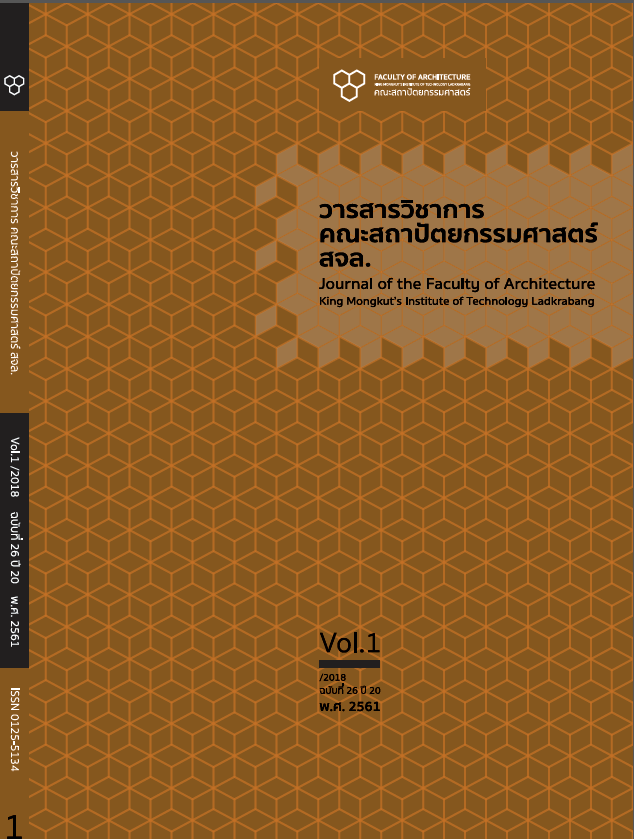การศึกษาแนวทางการปรับปรุงห้องเรียนสถาปัตยกรรมภายในกรณีศึกษา : คณะสถาปัตยกรรมศาสตร์ผังเมืองและนฤมิตศิลป์, An Investigation of Renovation Design for Interior Learning Classroom, Case Study: Faculty of Architecture Urban Design and Creative art
Main Article Content
Abstract
Abstract
This research is the study of the renovation for AR-412-2 classroom, Faculty of Architecture Urban and Creative Arts Mahasarakham University by studying the current physical environment, the behaviors between
the learner and the instructor in the activity area, and the problem of using interior space that directly affects to the learner. According to the survey, it was found that the area was not used as the expected
purpose which is the specific learning classroom for interior architecture in addition with physical problems such as unfavorable areas, lack of equipment and lack of technology equipment and also lack of the friendly-
learning environment. Data collections were conducted by the observation, questionnaire, interview and student assessment in the academic year 2016. The 100 samples were 1st- 5th year students in Interior Architecture classes, including teachers. To sum up, the appropriated classroom that response to activities and behaviors can motivate, encourage, enhance the learner learning skills, and beneficial to the instructor. The result shows that there are three design criteria 1) providing a variety of activities such as searching, learning, and meeting or group working and dividing an area for private uses including facilities, 2) designing an openplan layout to maximize visual interaction within the areas, 3) dividing an area into 2 zones, lecture area and group-working area. These areas should be divided with writable partition boards. In addition, design the classroom, it is suggested that materials for decorations, genius board, laptop, and internet system should be considered.
Keywords : Learning Space Design, Post Occupied Evaluation, Interior Learning Classroom, Self-Directed Learning
Article Details
This work is licensed under a Creative Commons Attribution-NonCommercial-ShareAlike 4.0 International License.
Copyright Transfer Statement
The copyright of this article is transferred to Journal of The Faculty of Architecture King Mongkut's Institute of Technology Ladkrabang with effect if and when the article is accepted for publication. The copyright transfer covers the exclusive right to reproduce and distribute the article, including reprints, translations, photographic reproductions, electronic form (offline, online) or any other reproductions of similar nature.
The author warrants that this contribution is original and that he/she has full power to make this grant. The author signs for and accepts responsibility for releasing this material on behalf of any and all co-authors.
References
มหาวิทยาลัยศิลปากร.
บุษกร รมยานนท์. (2558). การออกแบบพื้นที่สำหรับการเรียนรู้ด้วยตัวเองในมหาวิทยาลัย. วารสาร JAR คณะสถาปัตยกรรมศาสตร์และการผังเมือง มหาวิทยาลัยธรรมศาสตร์. 12(1), 15-28.
พรทิพย์ เรืองธรรม. (10 มีนาคม 2559). สัมภาษณ์โดย กิ่งกาญจน์ โสภณพิศุตม์. การออกแบบห้องเรียนเพื่อการเรียนรู้. คณะสถาปัตยกรรมศาสตร์ ผังเมืองและนฤมิตศิลป์ มหาวิทยาลัยมหาสารคาม.
วิมลสิทธิ์ หรยางกูร. (2541). พฤติกรรมมนุษย์กับสภาพแวดล้อม มูลฐานทางพฤติกรรมเพื่อการออกแบบและวางแผน.พิมพ์ครั้งที่ 3. กรุงเทพฯ: จุฬาลงกรณ์มหาวิทยาลัย.
วัฒนาพร ระงับทุกข์. (2552). แผนการสอนที่เน้นผู้เรียนเป็นศูนย์กลาง. พิมพ์ครั้งที่ 2. กรุงเทพฯ: แอล ที เพลส.
ศศิธร ขันติธรางกูร. (2551). การจัดการชั้นเรียนของครูมืออาชีพ. วารสารครุศาสตร์มหาวิทยาลัยราชภัฏเลย. 1(2), 1-19.
สุชาดา ศิริวิโรจน์. (2548). การออกแบบห้องเรียนเพื่อการใช้สื่อการสอนได้อย่างมีประสิทธิภาพ. กรุงเทพมหานคร: จุฬาลงกรณ์มหาวิทยาลัย.

